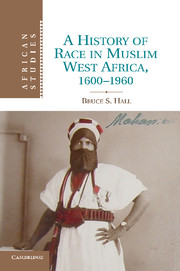Book contents
- Frontmatter
- Contents
- List of maps and figures
- Acknowledgments
- Note on orthography
- Abbreviations used in references
- Glossary
- Introduction
- PART ONE Race Along The Desert Edge, C. 1600–1900
- PART TWO Race And The Colonial Encounter, C. 1830–1936
- PART THREE The Morality of Descent, C. 1893–1940
- PART FOUR Race and Decolonization, C. 1940–1960
- Conclusion
- Index
- Misc-endmatter
- References
PART ONE - Race Along The Desert Edge, C. 1600–1900
Published online by Cambridge University Press: 05 August 2011
- Frontmatter
- Contents
- List of maps and figures
- Acknowledgments
- Note on orthography
- Abbreviations used in references
- Glossary
- Introduction
- PART ONE Race Along The Desert Edge, C. 1600–1900
- PART TWO Race And The Colonial Encounter, C. 1830–1936
- PART THREE The Morality of Descent, C. 1893–1940
- PART FOUR Race and Decolonization, C. 1940–1960
- Conclusion
- Index
- Misc-endmatter
- References
Summary
PRELUDE
A central argument of this book is that contemporary Sahelian constructions of race owe a great deal to ideas that were developed in the region before the arrival of European colonial forces at the end of the nineteenth century. The two chapters in Part One are about the intellectual history of race in Muslim West Africa before European occupation.
The principal geographical focus of this book is the West African Sahel, a band of arid subdesert land along the southern edge of the Sahara Desert stretching from the Atlantic coast in Mauritania and Senegal in the west to the vicinity of Lake Chad in the east. The use of the name “Sahel” to refer to this region is an academic and geopolitical convention today, but it stems from a colonial misnomer and European misunderstanding of western African uses of the Arabic word for “shore” (sāḥil), which properly refers to the northwestern edge of the Sahara. Because my goal in this book is to provide a history of how people in the West African Sahel came to distinguish between themselves along racial lines, I intentionally avoid geographical terms that suggest, however unintentionally, that there is a natural racial geography in West Africa. Historians sometimes refer to a region that they call the (Western or Central) “Sudan,” which is a broad term for the area north of the West African forest zone and south of the Sahara.
- Type
- Chapter
- Information
- A History of Race in Muslim West Africa, 1600–1960 , pp. 27 - 33Publisher: Cambridge University PressPrint publication year: 2011



